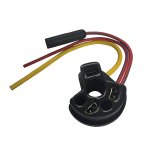- Joined
- Nov 3, 2003
- Messages
- 49,341
Ok, while I wasn't seeing the pic during my reply, the "black box" you mention should be the voltage regulator. I thought you might have meant the relay (black) or the fuse holder (also black) but now that I look again, I see your regulator is black also.
So you're mostly good.
Which alternator are you using?
If you have not upgraded to a more powerful and perhaps more modern alternator, I would consider doing so.
The aftermarket EFI setups may not be as sensitive to things as the factory bits are, but I have a feeling they are still going to like a full voltage maintained whenever the engine is running and you don't want the EFI to cough and sputter when you turn the heater and headlights on!
If you have other accessories that draw power, this is even more important.
So if you keep the original style alternator it should be at least 65a rated, and preferably more. Like in the 70-100 amp range.
That's why the modern internally regulated alternators like the 3G are such popular swaps these days. Easy way to get 95 to 130 amps and more of nice steady power.
And you'll be right in there with the new charge wire running directly from the BAT terminal of whatever alternator you use, to the battery side of the starter relay.
And speaking of that, I did not go into detail about that new charge wire before.
As you suggested, running a new charge wire from the BAT terminal to the battery side of the starter relay is a good idea. Makes the run nice and short with fewer potential problems.
But don't undersize the wire either. Even with a small alternator you should be using at least an 8ga wire. If you go with a 3G instead, go to a 6ga battery cable size wire.
This is not because 10ga can't handle it, because it actually can. But the larger wire helps to guarantee a better, more uninterrupted supply to the battery and to the electrical system.
And if you upgrade to a more powerful unit you will already be ready for it if you go with a larger wire now.
Paul
So you're mostly good.
Which alternator are you using?
If you have not upgraded to a more powerful and perhaps more modern alternator, I would consider doing so.
The aftermarket EFI setups may not be as sensitive to things as the factory bits are, but I have a feeling they are still going to like a full voltage maintained whenever the engine is running and you don't want the EFI to cough and sputter when you turn the heater and headlights on!
If you have other accessories that draw power, this is even more important.
So if you keep the original style alternator it should be at least 65a rated, and preferably more. Like in the 70-100 amp range.
That's why the modern internally regulated alternators like the 3G are such popular swaps these days. Easy way to get 95 to 130 amps and more of nice steady power.
And you'll be right in there with the new charge wire running directly from the BAT terminal of whatever alternator you use, to the battery side of the starter relay.
And speaking of that, I did not go into detail about that new charge wire before.
As you suggested, running a new charge wire from the BAT terminal to the battery side of the starter relay is a good idea. Makes the run nice and short with fewer potential problems.
But don't undersize the wire either. Even with a small alternator you should be using at least an 8ga wire. If you go with a 3G instead, go to a 6ga battery cable size wire.
This is not because 10ga can't handle it, because it actually can. But the larger wire helps to guarantee a better, more uninterrupted supply to the battery and to the electrical system.
And if you upgrade to a more powerful unit you will already be ready for it if you go with a larger wire now.
Paul















